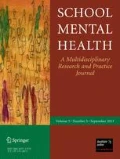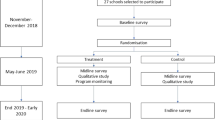Abstract
School staff provide key mental health services following mass crisis events and teachers, in particular, can provide important supports within their classrooms. This study examines Boston-area teachers’ perception of classroom-wide psychiatric distress and the types of supports that schools and teachers provided following the 2013 Boston Marathon bombing and subsequent manhunt. Boston-area K-12 teachers (N = 147) in communities with varying levels of exposure to the bombing and manhunt completed an anonymous web-based survey 2–5 months after the attack. Teachers reported on students’ exposure to the bombings and manhunt, classroom-wide psychiatric distress, and the types of supports they and their schools provided students. Teacher reports of student exposure to the bombings and manhunt were significantly associated with their perceptions of greater classroom-wide psychiatric distress. Almost half indicated that their school had no formal policy for responding to the crisis, half reported no training to address events, and even the most common classroom-based support strategy—reassuring students of their safety—was provided by only 76 % of teachers. Teacher perceptions of student exposure to the manhunt, but not the bombing, were significantly associated with greater provision of these supports. In the aftermath of the Boston Marathon bombings and manhunt, teachers and schools provided supports; however, the extent and types of supports varied considerably. Working with teachers to most effectively and consistently serve in this complex role has the potential to improve school-based crisis response plans, as well as student outcomes.
Similar content being viewed by others
References
Alisic, E. (2012). Teachers’ perspectives on providing support to children after trauma: A qualitative study. School Psychology Quarterly, 27, 51–59. doi:10.1037/40028590.
Brock, S. E., Lazarus, P. J., & Jimerson, S. R. (2002). Best practices in school crisis prevention and intervention. Bethesda, MD: National Association of School Psychologists.
Brock, S. E., Nickerson, A. B., Reeves, M. A., Jimerson, S. R., Lieberman, R. A., & Feinberg, T. A. (2009). School crisis prevention and intervention: The PREPaRE model. Bethesda, MD: National Association of School Psychologists.
Brown, J. D., Wissow, L. S., Gadomski, A., Zachary, C., Bartlett, E., & Horn, I. (2006). Parent and teacher mental health ratings of children using primary-care services: Interrater agreement and implications for mental health screening. Ambulatory Pediatrics, 6, 347–351. doi:10.1016/j.ambp.2006.09.004.
Comer, J. S., Dantowitz, A., Chou, T., Edson, A. L., Elkins, R. M., Kerns, C., et al. (2014). Adjustment among area youth after the Boston Marathon bombing and subsequent manhunt. Pediatrics, 134, 1–8.
Fairbrother, G., Stuber, J., Galea, S., Pfefferbaum, B., & Fleischman, A. R. (2004). Unmet need for counseling services by children in New York City after the September 11th attacks on the World Trade Center: Implications for pediatricians. Pediatrics, 113(5), 1367–1374.
Felix, E., Vernberg, E. M., Pfefferbaum, R. L., Gill, D. C., Schorr, J., Boudreaux, A., et al. (2010). Schools in the shadow of terrorism: Psychosocial adjustment and interest in interventions following terror attacks. Psychology in the Schools, 47(6), 592–605. doi:10.1002/pits.20493.
Furr, J. M., Comer, J. S., Edmunds, J. M., & Kendall, P. C. (2010). Disasters and youth: A meta-analytic examination of posttraumatic stress. Journal of Consulting and Clinical Psychology, 78(6), 765–780. doi:10.1037/a0021482.
Galea, S., Ahern, J., Resnick, H., Kilpatrick, D., Bucuvalas, M., Gold, J., et al. (2002). Psychological sequelae of the September 11 terrorist attacks in New York City. New England Journal of Medicine, 346, 982–987.
Goodman, R. (2001). Psychometric properties of the strengths and difficulties questionnaire. Journal of the American Academy of Child and Adolescent Psychiatry, 40, 1337–1345. doi:10.1097/00004583-200111000-00015.
Goodman, R., Ford, T., Simmons, H., Gatward, R., & Meltzer, H. (2000). Using the Strengths and Difficulties Questionnaire (SDQ) to screen for child psychiatric disorders in a community sample. British Journal Psychiatry, 177, 534–539.
Graham, J., Shirm, S., Liggin, R., Aitken, M. E., & Dick, R. (2006). Mass-casualty events at schools: A national preparedness survey. Pediatrics, 117(1), e8–e15. doi:10.1542/peds.2005-0927.
Hoven, C. W., Durante, C. S., Lucas, C. P., Wu, P., Mandell, D. J., Goodwin, et al. (2005). Psychopathology among New York City public school children 6 months after September 11. Archives of General Psychiatry, 62, 545–551.
Hughes, M., Brymer, M., Chiu, W. T., Fairbank, J. A., Jones, R. T., Pynoos, R. S., et al. (2011). Posttraumatic stress among students after the shootings at Virginia Tech. Psychological Trauma: Theory, Research, Practice, and Policy, 3, 403–411. doi:10.1037/a0024565.
Huston, T. A., & DiPietro, M. (2007). In the eye of the storm: Students’ perceptions of helpful faculty actions following a collective tragedy. In D. R. Robertson & L. B. Nilson (Eds.), To improve the academy: Vol. 25, resources for faculty, instructional and organizational development (pp. 207–224). Bolton, MA: Anker.
La Greca, A. M., Vernberg, E. M., Silverman, W. K., Vogel, A. L., & Prinstein, M. J. (1994). Helping children prepare and cope with natural disasters: A manual for professionals working with elementary school children. Miami, FL: Authors.
McLaughlin, K. A., Busso, D. S., Duys, A., Green, J. G., Alves, S., Way, M., et al. (2014). Amygdala response to negative stimuli predicts PTSD symptom onset following a terrorist attack. Depression and Anxiety, 31(10), 834–842.
McLaughlin, K. A., Green, J. G., Gruber, M. J., Sampson, N. A., Zaslavsky, A. M., & Kessler, R. C. (2010). Childhood adversities and adult psychiatric disorders in the national comorbidity survey replication II: Associations with persistence of DSM-IV disorders. Archives of General Psychiatry, 67(2), 124–132. doi:10.1001/archgenpsychiatry.2009.187.
Merikangas, K. R., He, J., Burstein, M., Swendsen, J., Avenevoli, S., Case, B., et al. (2011). Service utilization for lifetime mental disorders in U.S. adolescents: Results of the national comorbidity survey-adolescent supplement (NCSA). Journal of the American Academy of Child and Adolescent Psychiatry, 50, 32–45. doi:10.1016/j.jaac.2010.10.006.
Nickerson, A. B., & Zhe, E. J. (2004). Crisis prevention and intervention: A survey of school psychologists. Psychology in the Schools, 41, 777–788. doi:10.1002/pits.20017.
Pfefferbaum, B., Gurwitch, R. H., Doughty, D. E., Foy, D. W., Pfefferbaum, R. L., Pynoos, R., et al. (2004). Teachers’ psychological reactions 7 weeks after the 1995 Oklahoma City bombing. American Journal of Orthopsychiatry, 74, 263–271. doi:10.1037/0002-9432.74.3.263.
Pfefferbaum, B., Nixon, S. J., Tucker, P. M., Tivis, R. D., Moore, V. L., Gurwitch, R. H., et al. (1999). Posttraumatic stress responses in bereaved children after the Oklahoma City bombing. Journal of the American Academy of Child and Adolescent Psychiatry, 38, 1372–1379.
Pfefferbaum, B., Sconzo, G. M., Flynn, B. W., Kearns, L. J., Doughty, D. E., Gurwtiz, R. H., et al. (2003). Case finding and mental health services for children in the aftermath of the Oklahoma City Bombing. The Journal of Behavioral Health Services & Research, 30, 215–227.
Reinke, W. M., Stormont, M., Herman, K. C., Puri, R., & Goel, N. (2011). Supporting children’s mental health in schools: Teacher perceptions of needs, roles, and barriers. School Psychology Quarterly, 26, 1–13.
State, P. M., Kern, L., Starosta, K. M., & Mukherjee, A. D. (2011). Elementary pre-service teacher preparation in the area of social, emotional, and behavioral problems. School Mental Health, 3, 13–23. doi:10.1007/s12310-010-9044-3.
Stuber, J., Fairbrother, G., Galea, S., Pfefferbaum, B., Wilson-Genderson, M., & Vlahov, D. (2002). Determinants of counseling for children in Manhattan after the September 11 attacks. Psychiatric Services, 53, 815–822.
U.S. Department of Health and Human Services. (2012). Tips for talking with and helping children and youth cope after a disaster or traumatic event: A guide for parents, caregivers, and teachers (HHS Publication No. SMA 12-4732). Washington, DC: U.S. Government Printing Office.
Acknowledgments
This project was supported by Grant Numbers K01MH085710 and K23MH090247 from the National Institute of Mental Health to J. Green and J. Comer and by funding from the Boston University School of Education.
Conflict of interest
No authors have conflicts of interest to disclose.
Author information
Authors and Affiliations
Corresponding author
Rights and permissions
About this article
Cite this article
Green, J.G., Holt, M.K., Kwong, L. et al. School- and Classroom-Based Supports for Children Following the 2013 Boston Marathon Attack and Manhunt. School Mental Health 7, 81–91 (2015). https://doi.org/10.1007/s12310-014-9140-x
Published:
Issue Date:
DOI: https://doi.org/10.1007/s12310-014-9140-x



